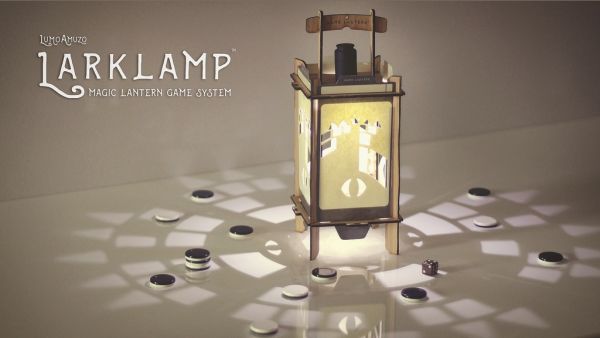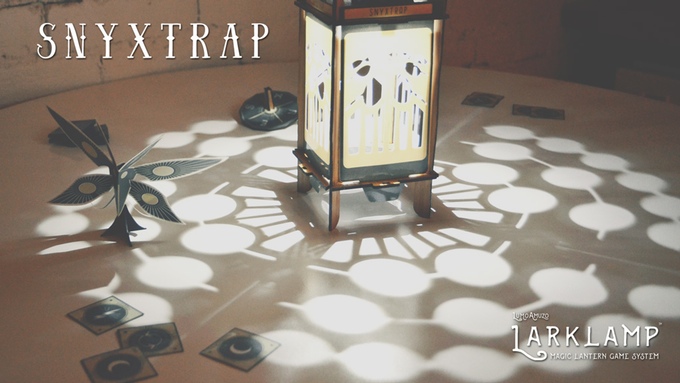Dreams and Lanterns: An Interview with Larklamp Creator P. D. Warne

Most people can remember at least one pretty crazy or vivid dream they had in their life. Whether it made their skin crawl, or filled them with joy, dreams can be powerful things. For game developer P.D. Warne, dreams led him down an unexpected career path which culminated in the creation of his Kickstarter project, the Larklamp.
The Larklamp is a new tabletop gaming platform that uses light and shadows to create the board that players use for their game. It functions similarly to classic parlor devices like the camera obscura or kaleidoscopes. A single LED light illuminates the inside of the small wooden Larklamp and projects the shapes cut into the side panels of the gaming system. This in turn forms the board for the particular game players will experience. These panels can be swapped out to provide different gaming experiences, and Warne plans on creating a series of different games to be played with his unique platform.
Warne spent 15 years developing video games with studios like Lucas, Double Fine, Hololabs, and Ubisoft. When he decided to go independent he naturally thought he would be entering the indie video game industry. However, he was surprised where he found himself after a particularly vivid dream he experienced while watching an iconic animated film by director Hayao Miyazaki. We sat with Warne to learn more about the origins of the Larklamp, and what made an experienced video game developer turn to tabletop to find expression.
Jesse Tannous: What was the exact moment when you were struck by the possibility of the Larklamp?
P.D. Warne: While re-watching the movie Spirited Away for the umpteenth time, I fell asleep on my couch (as tired parents of young children are want to do). I then had a fantastic dream about the characters and setting of the film, which takes place in the spirit world and centers around a magical bath house – imagine a surreal spa for weary spirits – owned and operated by a witch named Yubaba.
In the dream I was an impoverished spirit visiting Yubaba's Bath House. I had no money to pay for their services, so I offered to build Yubaba a new game in exchange for my stay. She agreed, but on the condition that she enjoyed the game I was to create. I was given a small workspace down in the Bath House’s boiler room. Exploring the building, and observing the other spirit guests, I became inspired to use the lanterns I found around the Bath House to create the game.
When I presented the completed game lantern to Yubaba she was initially enchanted, but then became furious to discover it featured cooperative gameplay. As she was about to transform me into a small reptile, we heard laughter and cheers from the floors below. These sounds were coming from the Bath House guests who were playing my lantern games. What made her paying guests happy made Yubaba happy, so she accepted my game as payment, and commanded that I was to receive the Bath House’s most prestigious treatment as my reward.
But before I was could receive this amazing treatment I awoke on the couch with the movie credits rolling, and with nothing more than a stiff neck. I do believe that witch tricked me in the end. However I did end up with the initial idea for the Larklamp.

JT: Until this point your game development career focused mostly on digital games. What prompted the jump to tabletop, especially to this very unique platform?
P.D.W: It was not an easy decision to make that jump. I had fifteen years of experience in videogames and I naturally assumed that’s what I would be making when I moved to solo “indie" game development. As I began to explore the games I wanted to create, I came to understand they didn’t want to be built on top of any existing platforms. I adore so many wonderful games built by the talented developers for all the incredible videogame systems, but there was something about the physical and social qualities of analog/tabletop that fit the lantern concept so well. I then understood I didn't want to make a videogame about the Larklamp, I wanted to build the Larklamp itself. After this I became even more inspired about tabletop by learning about all the phenomenal indie developers, publishers, and games that have emerged over the past decade or so.
JT: What sorts of specialized game development challenges comes with creating experiences for the Larklamp?
P.D.W: Tabletop design posed many new development challenges for me. When working on a videogame you will eventually test computational statistics to ensure your game runs smoothly within the constraints of system memory and the GPU/CPU. With the Larklamp development, I now have a kitchen scale on my workbench for weighing game pieces, and a list of shipping dimensions tacked upon the wall– all to keep the Larklamp and its games within various shipping constraints (postal bandwidth!).
As for developing Larklamp games, you must pay careful attention to the size and art style of game pieces to ensure they remain legible in the low light conditions. Even with the crispest LED, the "board" (the light and shadows cast from the lantern) can only be a certain resolution, so conveying certain types of spatial information has to be approached differently than with printed boards. The lighting of the lantern also lends itself to a certain atmosphere and ambiance that needs to be designed for, which naturally fits my own interests around themes of dreams, illusion, magic, fantasy, and the like.

JT: You describe this as your ideal platform for designing games, what is it about the Larklamp that connects with you on such a powerful level?
P.D.W: I believe that life is a game of shadows.
There is little question life is very real and material, but we often forget that it can also be an illusion—a construct of our imaginations. Much of the suffering we experience stems from our forgetting about this illusory quality of our lives. We’re constantly playing a game where we attempt to hold onto passing shadows, and we grow frustrated, sad, and confused that we never seem to be able to win at this game.
This is a very old story passed down through the ages—from Plato's Allegory of the Cave, to the teachings of the Buddha, to the Matrix movies. I hope that by playing the Larklamp and its games my children (and perhaps theirs as well) may occasionally be reminded to be a little more attentive to this illusory quality of life than I have been.
JT: Your Kickstarter has already vastly exceeded your original funding goals, what does this added support mean for the future of the Larklamp?
P.D.W: With the amazing reception the Larklamp has received from both the Kickstarter community and from PAX East attendees, this project will now become a full-time endeavor for me. Aside from obviously fulfilling the rewards and stretch goals on time, I hope to reveal more to the community about the other Larklamp games I wish to make for them. When they see how these additional games are going to play—how the light and shadows of the Larklamp will offer a variety of new game mechanics unique to the system—I believe they will be as pleasantly surprised as when they first saw the Larklamp. I am also committed to solving international shipping by the time the Larklamp is released commercially, in order to reach all the players around the world who have shown so much interest (and patience!) as I work toward a solution.
The Larklamp’s Kickstarter campaign is scheduled to continue until May 15, and has already acquired nearly $25,000 of its original $3,500 goal. For additional information on the Larklamp make sure to visit the Kickstarter page , or Warne’s official website .




